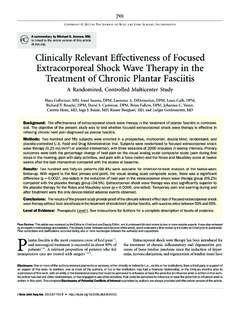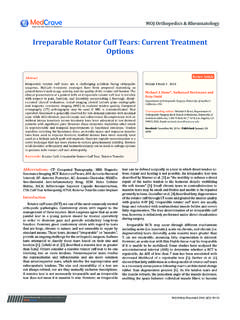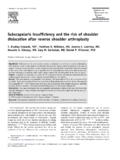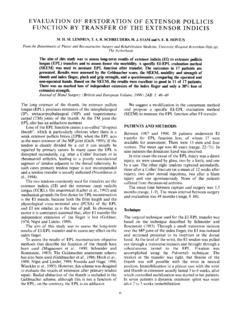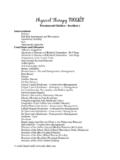Transcription of Corrective Midfoot Osteotomies - Ankle & Foot …
1 Corrective Midfoot OsteotomiesJohn J. Stapleton, DPM, AACFASa,b,Lawrence A. DiDomenico, DPM, FACFASc,Thomas Zgonis, DPM, FACFASd,*aFoot and Ankle Surgery, VSAS Orthopaedics, Lehigh Valley Hospital, Cedar Crest Campus,Allentown, PA, USAbPenn State College of Medicine, 500 University Drive, Hershey, PA 17033, USAcAnkle and Foot Care Center, 8175 Market Street, Boardman, OH 44512, USAdDepartment of Orthopaedics/Podiatry Division, The University of Texas Health ScienceCenter at San Antonio, 7703 Floyd Curl Drive (MSC 7776), San Antonio, TX 78229, USAC orrective Osteotomies about the Midfoot are indicated for angular androtational deformities. Appropriate positioning of the osseous segments fol-lowing Midfoot osteotomy is challenging because of influential forcesaround the hindfoot/ Ankle and the forefoot that must be considered. Ini-tially, Midfoot Osteotomies were reserved for the correction of the severerigid pes cavus foot[1].
2 Currently, surgeons have used angular, rotational,and translational deformity corrections that can be achieved through themidfoot, expanding the indications for an osteotomy through this regionof the foot[2 4]. In addition, Midfoot Osteotomies often avoid the extensivesoft tissue exposure required for multiple joint arthrodesis proceduresbecause these procedures can be performed through minimum or percutane-ous incisions[5]. Typical indications for a Midfoot osteotomy are rigid pescavus, talipes equinus-varus, rigid metatarsus adductus, malunions associ-ated with Midfoot or rearfoot arthrodesis, and Charcot neuro-osteoarthrop-athy Midfoot deformities[1,3,4,6 11].The goal of a Corrective Midfoot osteotomy is to re-establish a plantigradefoot during stance, which implies that the first metatarsal head, fifth metatar-sal head, and calcaneus are on the same plane during stance. Limited normalparameters exist for performing Midfoot Osteotomies and it is therefore imper-ative that the surgeon have detailed knowledge and sound understanding ofall compensatory joint motions that exist proximal and distal to the intendedosteotomy to achieve successful deformity correction through the Midfoot .
3 * Corresponding Zgonis).0891-8422/08/$ - see front matter 2008 Elsevier Inc. All rights Podiatr Med Surg25 (2008) 681 690 Physical examinationThe physical examination must be systematic and should include evalua-tion of the entire lower extremity when non weight bearing, during stance,and while ambulating. Emphasis is placed on identifying the apex of thedeformity and compensatory motion or joint contractures that are should be evaluated in regards to its length, angulation, rotation,and translation. In the foot, particularly in the Midfoot region, this evalua-tion can become challenging because of the short osseous segments and mul-tiple articulations proximally and distally. For this reason, it is important toestablish clinical parameters and to correlate those findings with the neces-sary radiographs to provide an adequate description of the deformity to becorrected. The contralateral extremity, if unaffected, facilitates the examina-tion and serves as an internal control for the patient.
4 The surgeon must eval-uate the deformity in the frontal, sagittal, and transverse planes to planadequately the necessary osteotomy, realignment, and adjunctive proce-dures that may be required to restore a plantigrade foot. Radiographs areobtained to evaluate the deformity and to create reference lines to facilitateprecise surgical planning. Weight-bearing anterior-posterior and lateralradiographs of the lower leg, Ankle , and foot, along with a hindfoot align-ment view, must be obtained and correlated with the clinical importance of weight-bearing radiographs for the evaluation of thedeformity cannot be overstated because subtle deformities not readily ap-parent on clinical examination become easily detected. If the patient sweight-bearing lower leg radiographs demonstrate proximal deformity orlimb length discrepancy, then weight-bearing anterior-posterior and lateralmechanical axis radiographs should be obtained from the hip to the mechanical axis is a line drawn from the center of the femoral head tothe center of the Ankle joint.
5 If the mechanical axis deviates more than 1 cmfrom the center of the knee joint, then a deformity proximal to the Ankle islocated in the tibia or femur. Understanding the influence of supra-pedalstructural deformities is paramount, particularly when these supra-pedalstructural deformities exceed the range of motion that is present in compen-satory joints about the foot and Ankle . For example, a varus deformity ofthe tibia can lead to fixed subtalar joint inversion and compensatory fore-foot valgus. Conversely, a valgus deformity of the tibia can lead to fixed sub-talar joint eversion and compensatory forefoot varus. The development ofthese foot and Ankle deformities from proximal deformities of the tibiaand femur depend on the compensatory range of motion throughoutthe foot and Ankle . At times, these deformities may require Osteotomies ofthe rearfoot/ Ankle , tibia, or femur, in addition to the Midfoot , to achieve thedesired of the forefoot and the rearfoot is paramount in planning fora Midfoot osteotomy.
6 The surgeon should examine rearfoot position whennon weight bearing and during stance. It should be determined if forefoot682 STAPLETONet alposition is influencing rearfoot deformity and vice versa. The forefootshould be plantigrade, allowing for equal transfer of weight throughoutthe foot. Forefoot varus produces increased weight transfer to the lateralborder of the foot and may cause a compensatory calcaneal valgus defor-mity. Conversely, forefoot valgus deformities produce increased weighttransfer to the medial border of the foot and may cause a compensatory cal-caneal varus deformity. Deformities about the forefoot can usually be cor-rected with Midfoot Osteotomies . Forefoot varus and valgus are usuallycorrected through rotation of the forefoot segment following midfootosteotomy. Sagittal and transverse plane forefoot deformities can be cor-rected with wedge-based Midfoot Osteotomies and translation, , an attempt to correct noncompensatory deformities and fixedcompensatory deformities about the rearfoot, particularly the calcaneusand subtalar joint, with Midfoot Osteotomies should not be attempted.
7 Acalcaneal osteotomy or subtalar joint arthrodesis, in addition to a correctivemidfoot osteotomy, is needed for these associated rearfoot deformities[6].Correction through the Midfoot will not correct a rearfoot deformity unlessthe deformity was compensatory to the deformed forefoot position and jointcontracture has not developed. An example would be a fixed forefoot varuswith a compensatory heel valgus. When a block is placed preoperatively un-der the forefoot, the calcaneus inverts from its valgus position, resuminga neutral position. In this case scenario, a Midfoot osteotomy to correctthe fixed forefoot varus will simultaneously correct the calcaneal valgusthat was compensatory with no evidence of subtalar joint plane deformities in the pes cavus foot are a frequent indicationfor a Midfoot osteotomy[1,7,11]. The osteotomy is designed with a dorsallybased wedge to dorsiflex the forefoot and decrease the arch height[1,7,11].
8 At times, a wedge osteotomy has to be taken from the navicular-cuneiformjoint extending into the cuboid to obtain adequate correction. Anteriorequinus of the forefoot can be corrected with a Midfoot dorsally basedwedge osteotomy. Procurvatum deformities and Ankle equinus cannot becorrected with a Midfoot osteotomy, and additional soft tissue or osseousprocedures about the Ankle are required. It is important to evaluate theankle on lateral weight-bearing radiographs for procurvatum and recurva-tum deformities of the Ankle . At times, dorsiflexory stress radiographs areindicated to ensure an anterior osseous impingement is not evident at theankle and that sufficient Ankle joint dorsiflexion remains when consideringcorrection of an anterior equinus by way of a Midfoot osteotomy. In addi-tion, posterior osseous cavus deformities should be corrected with calcanealosteotomies, as opposed to Midfoot Osteotomies [6,9].
9 Plantar-based mid-foot wedge Osteotomies can be used to correct a Charcot Midfoot deformity[8]. The authors have found that a Midfoot osteotomy in a Charcot foot isbest performed if complete consolidation and stability exist about the mid-foot[12 14]. The clinical scenario in which a Midfoot osteotomy would beindicated for a Charcot foot is one with a plantar Midfoot ulcer as a result683 Corrective Midfoot OSTEOTOMIESof a rigid, stable, rocker-bottom deformity[13,14]. If instability persists,a Midfoot osteotomy should be avoided and an extended joint arthrodesisshould be considered instead[13,14].Rotational alignment should be determined and quantified. Radiographsto measure rotation are difficult and not routinely used. Clinical examinationis used to determine the presence and degree of rotational the patient seated, the knee is flexed at 90 , the patellar tubercle isplaced directly anterior, and the malleoli position is obtained and assessedfor rotational deformity.
10 At this point, a line drawn along the anterior tibialcrest is made and the bisection should be aligned with the second degree of internal (ie, abduction) and external (ie, adduction) rotation isthen quantified using a goniometer. In difficult cases with marked rotationand suspected proximal deformity, it may be necessary to obtain computer-ized axial tomography of the hip, distal femur, proximal tibia, and Ankle mal-leoli to define the rotational deformity more of joint range of motion is paramount and cannot be over-looked. Flexibility of the foot is determined. Compensatory rigid joint con-tractures, particularly of the subtalar joint, need to be determined. Inaddition, hypermobility and joint laxity of the first ray are considered relativecontraindications for performing a Midfoot osteotomy unless they areaddressed. Soft tissue contractures should be evaluated and adjunctive softtissue releases performed in conjunction with the Midfoot osteotomy[15].
